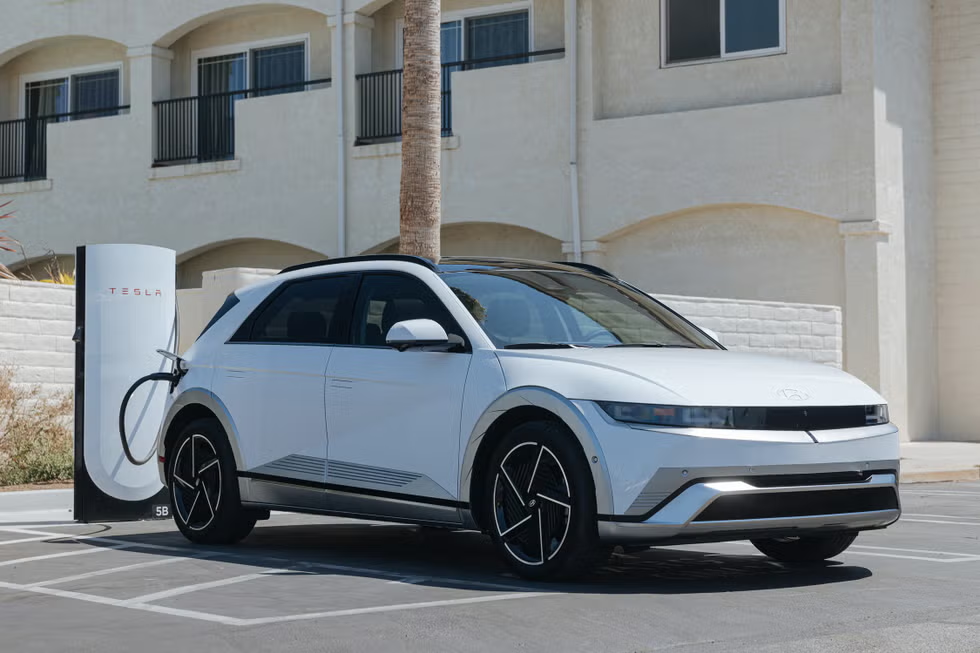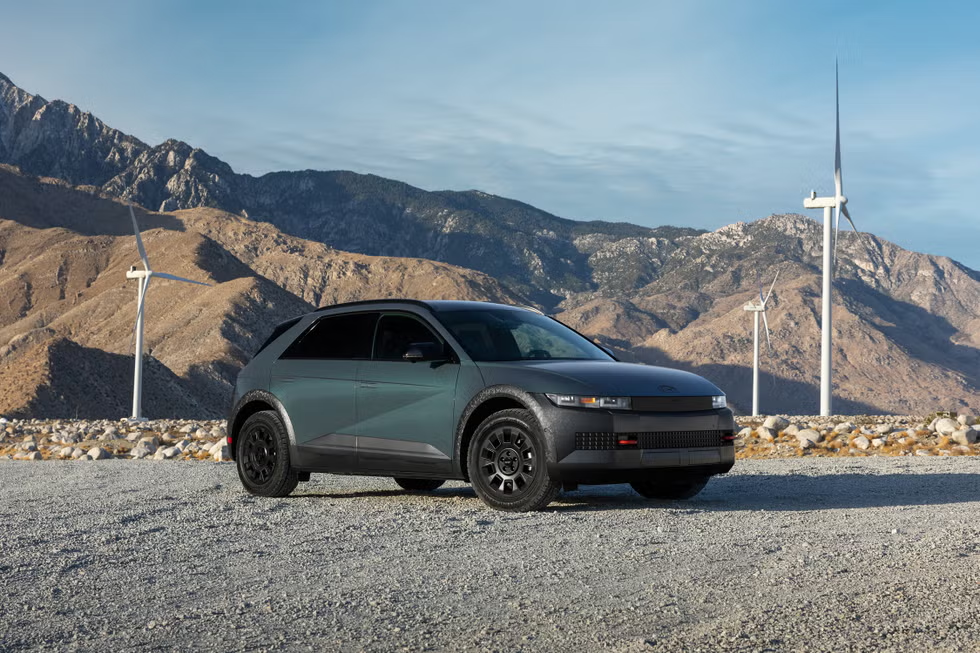Sign up for daily news updates from CleanTechnica on email. Or follow us on Google News!
You know those mirrors that say “Warning. Objects May Be Closer Than They Appear?” The Hyundai battery electric Ioniq 5 could have a similar warning that says, “Car May Be Larger Than It Seems.” I used to own a Dodge Colt hatchback and it was a tight fit for four people plus a large stuffed bear I won at Circus World. The Hyundai Ioniq 5 looks a lot like that Colt, but people are continuously surprised by how much bigger it looks in person and how roomy it is inside.
The Ioniq 5 has been with us for 4 years and is now being assembled at the new Hyundai factory in Georgia. It was the first car from Hyundai to use the E-GMP platform designed for mid-to-large EVs with rear- or all-wheel drive. The Ioniq 5 uses 800-volt architecture, which gives the car excellent DC fast charging capability. For 2025, the company has tweaked the appearance of the car to give it a bit more eye appeal and added a ruggedized XRT variant for those who like to take their cars off-road. ArsTechnica charts the changes, some of which are minor and some more significant. The tweaks for model year 2025 are subtle as far as midlife upgrades go.
There is a new wheel design and some of the details at the front and rear bumper are more pronounced to “accentuate the CUVness” of the car, according to Brad Arnold, head of exterior design at Hyundai Design. Inside, customers will find a revised center console, upgraded infotainment with wireless support for Apple CarPlay and Android Auto, and an updated steering wheel with lights that indicate the battery’s state of charge. A small but important tweak is that Hyundai has added a rear windshield wiper, something no hatchback should do without.

New battery packs are available this year. The $42,500 SE standard range Ioniq 5 gets a bump from 58 kWh to 63 kWh, which gives it a range of 245 miles (394 km), up from 220 miles (354 km). All other versions now use an 84 kWh pack, up from 77.4 kWh in last year’s model. For the most range, drivers will want a single-motor, rear-wheel-drive car with a rated range of 318 miles (511 km). That car is available in either SE ($46,550), SEL ($49,500), or Limited ($54,200) trim. For the all-wheel-drive SE ($50,500) and SEL ($53,000) trims, range increases by a useful 30 miles (48 km) to 290 miles (467 km) on a full charge. The $58,100 AWD Limited gets less of a range boost and is rated at 269 miles (432 km).
The Hyundai Ioniq 5 for the North American market now comes with a NACS charging port that allows drivers to use the Tesla Supercharger network. A CCS adapter is included. Thanks to its 800-volt architecture, the car can charge from 20 percent to 80 percent in 20 minutes using a 350 kW DC fast charger or in about 30 minutes using a Tesla Version 3 Supercharger. Drivers can now precondition the battery manually and Hyundai says plug-&-charge functionality will come soon via an over-the-air software update. After a test drive in southern California, Car and Driver found that the updated car has stable handling and abundant torque that makes quick work of twisty mountain roads. The suspension is slightly firmer than before, but steering feel remains less responsive than the test drivers preferred.
Ioniq 5 XRT Likes To Play In The Dirt

Hyundai also has a new trim level for the Ioniq 5 called XRT that features a 0.9 inch suspension lift, all-terrain tires mounted on steelie-inspired 18 inch wheels, and new front and rear fascias that accent the off-road vibe and wear a subtle pixelated camouflage pattern. The XRT is a dual-motor, all-wheel-drive model only. Hyundai has upgraded its approach and departure angles to 19.8 degrees for approach and 30.0 degrees for departure versus 17.5 and 25.4 degrees for other models. Functional, red-painted recovery hooks add an extra element of ruggedness to the XRT’s front end, and three terrain-specific driving modes — Snow, Mud, and Sand — can be selected via a button on the steering wheel’s lower spoke. Range with the more aggressive tires is 259 miles (417 km). Priced at $56,875, it is a direct competitor to the Ford Mustang Mach-E Rally and would make an excellent battery electric alternative to something like a Subaru Crosstrek outfitted for off-road driving.
Several test drivers got to take the XRT through the dirt and all reported the car handled off-road driving with aplomb. Car and Driver reports the sandy trails at the off-road park were dotted with bowling ball-sized rocks, sagebrush scrub, and shallow gullies, all of which the Ioniq 5 XRT handled just fine. It concluded its coverage of the updated Ioniq 5 with this accolade: “What we’re seeing here is Hyundai covering all of its bases. From the price leader SE to the posh Limited, and from the rugged XRT to the rowdy Ioniq 5 N, this particular lineup of electric crossovers works so well because its foundation is strong.” The updates endowed on the 2025 model are minor, but they’re still impactful, and they should keep this EV plenty relevant going forward.
InsideEVs is just as straightforward with its praise. It says that over the past few years, one car in particular has emerged as perhaps the strongest pound for pound Tesla Model Y alternative in the US market — the Hyundai Ioniq 5. The car’s retro-futuristic looks, good range, class leading charging speeds, affordable lease deals, and high-performance N variant have all helped it rack up acclaim, awards, and sales. All in all, the progress is remarkable for a car that didn’t even really need much upgrading. Other automakers are using this uncertain moment of EV growth to slow down and maybe coast a bit until the market heats up at the end of this decade. Not Hyundai. The company is pressing its early advantage. All told, these are among the most significant upgrades we’ve seen yet to any EV on the market, and proof that the Korean automaker has no plans to slow down.
Hyundai has sold more than 100,000 of them since 2021 in the US. When the Hyundai Motor Group’s combined brands came in second to Tesla in US electric sales last year, it was the Ioniq 5 that led the charge. The car has served another important role for Hyundai. It has helped reset its brand identity, going from a budget player to a world leader in electrification, style, and technology. The Ioniq 5 should be on everyone’s shopping list if they are thinking of getting an electric car today.
Chip in a few dollars a month to help support independent cleantech coverage that helps to accelerate the cleantech revolution!
Have a tip for CleanTechnica? Want to advertise? Want to suggest a guest for our CleanTech Talk podcast? Contact us here.
Sign up for our daily newsletter for 15 new cleantech stories a day. Or sign up for our weekly one if daily is too frequent.
CleanTechnica uses affiliate links. See our policy here.
CleanTechnica’s Comment Policy



